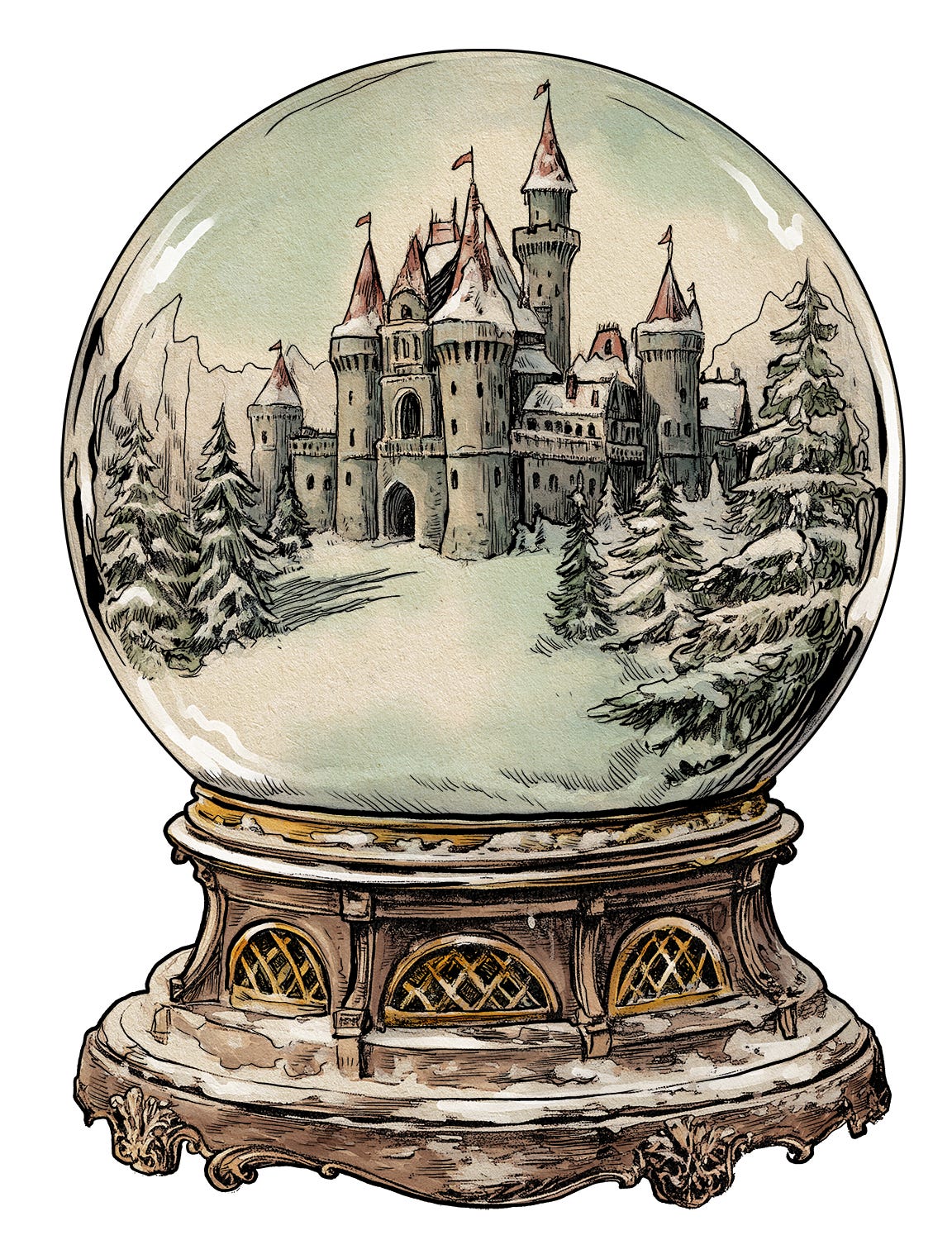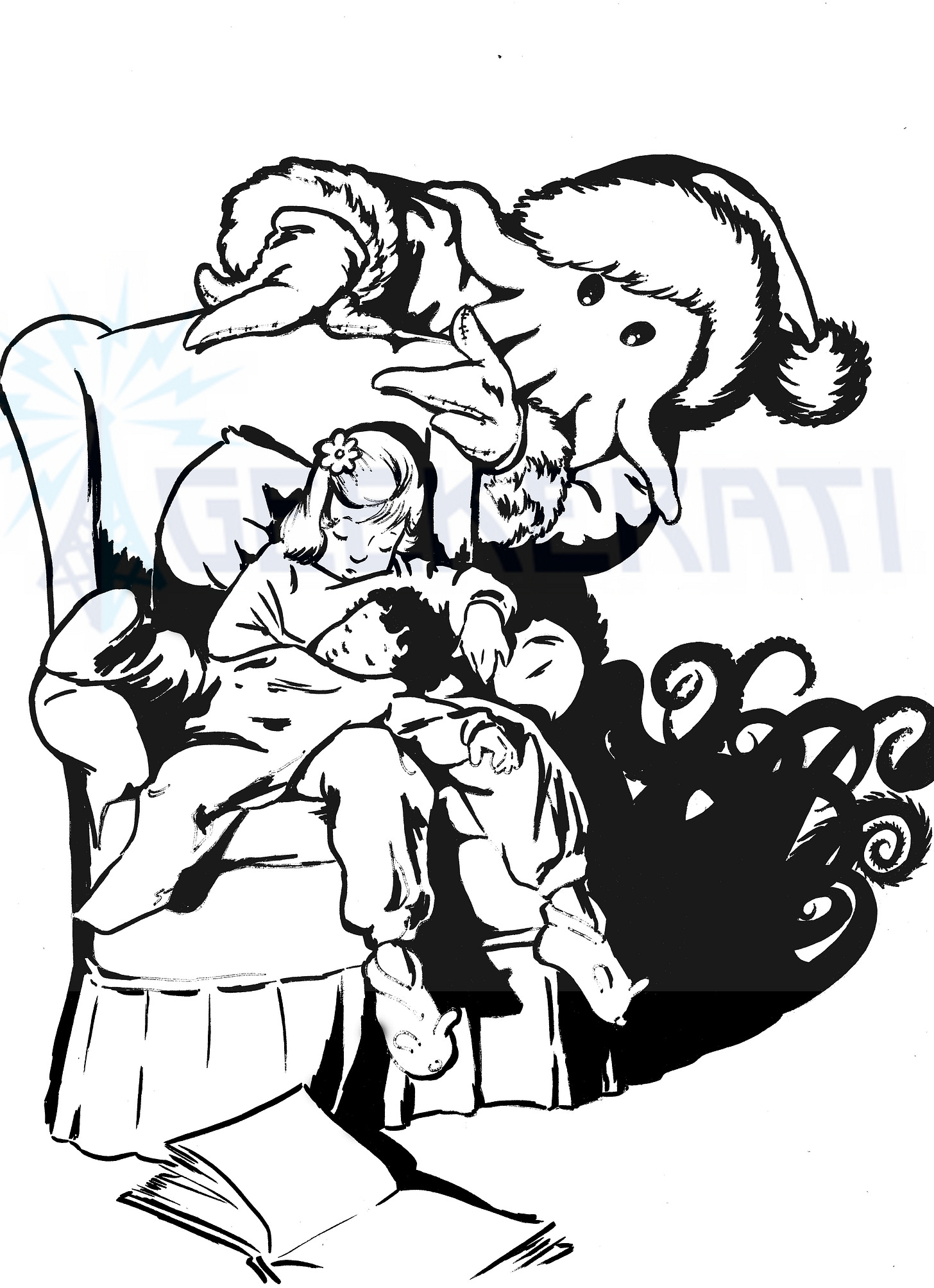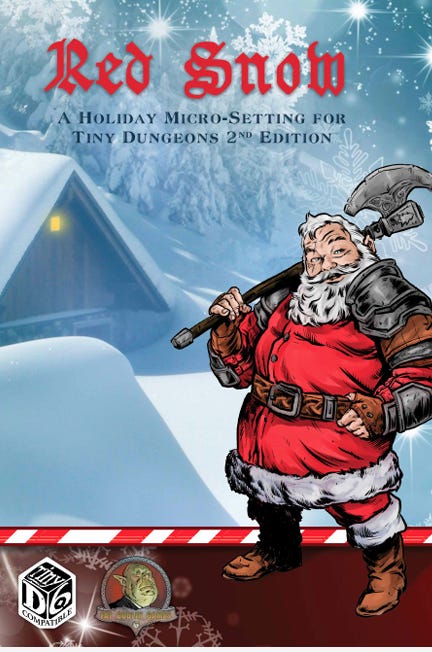Weekly Geekly Rundown for December 13, 2024
Friday the 13th! Ch Ch Ch Ch...ha...ha...ha...ha

Why Kids Always Get Socks for Christmas: The Jólakötturinn
If you ever wondered if there was a Christmas Kaiju, the answer is yes. The Jólakötturinn of Icelandic lore fits the role nicely and eats young children who don’t get new clothes for Christmas. So make sure to get the kids clothes and fathers those tacky ties, otherwise it’s into Jólakötturinn’s maw they go. The character is heavily featured in Christmas is Coming by Jóhannes úr Kötlum and this entertaining PBS video explains the history of the character.
The Lamentations of Luke Y. Thompson
I mentioned earlier in the year that one of the venues Luke writes/wrote for decided to shift away from thoughtful human generated content and toward AI generated spam. I didn’t phrase it that way, but I was disappointed in the venue. Luke is a talented writer and he and other writers on the site deserved better. It looks like that kind of stupidity is contagious though as BuzzFeed is selling off First We Feast (the makers of Hot Ones) at a major loss so that they can focus on their core competency, producing autogenerated crap that maximizes SEO and minimizes analysis. Luke was the victim of a bad policy, but he’s in good company and he has taken the time to focus on his own core competency which is writing thoughtful stuff and building his own brand.
Luke, who I hope will continue to write here, has fully committed to his own Substack where he will discuss films, fast food, and other topics that interest him. Earlier this week he did a quick rundown of his thoughts on the films getting a lot of Buzz this Awards Season. It’s a collection of the comments he’s made on various social media, but transforming microblogs into full blog posts is exactly what Substack is for. LYT Rules is still building up his subscriber base, heck so am I, but I recommend checking him out.
Courtney Howard’s View from the Center Seat
While my personal habit in this season is to fill it with Christmas movies ranging from Hollywood Classics to saccharine Hallmark productions, there is a long tradition of releasing horror films at this time of year. Not everyone is celebrating this time of year and running counterprogramming is a powerful and legitimate corporate strategy. Given that today is also Friday the 13th, there’s another reason it’s natural to talk about a horror movie. December is also the month a lot of films that hope to win Oscars get released. It’s good to take advantage of recency bias if you can.
This year a film that fits both those criteria, in that it’s a horror film that hopes to get some Oscar traction, with Robert Eggers’ Nosferatu. Eggers is a talented director who has an amazing ability to direct compelling and haunting narratives that make us feel comfortable enough to experience the horror within them. Films like The Witch and The Northman warn us of how disturbing they will be in the end and yet follow the tale to the end as if we were sitting by a fire listening to a masterful storyteller with a rich Welsh accent reciting a campfire tale.
It’s not that the impact sneaks up on us, it’s that everything is so rich and moody that we want to experience the films in spite of the disturbing moments. We are rewarded with rich commentary on the human condition and shown beautifully crafted imagery that feels authentic even as we maintain a filmic distance.
Courtney Howard recently reviewed Nosferatu with her most positive review of the year at FreshFiction.tv. She rated the film 5/5 stars and in the review she highlights immediately how Eggers “focuses his lens on female desire and repression.” That of course is the central to any Gothic tale, and Nosferatu/Dracula is a quintessentially Gothic tale. In this milieu sex and death are one and the same. From Anne Radcliffe’s novels like The Mysteries of Udolpho to Jane Eyre, the psychological connection between sexual desire and danger is at the fore. When Jane Austen wrote her deconstruction of the genre, Northanger Abbey, she focuses on these well understood and emotionally powerful tropes. She uses them in a powerful manner, even as she highlights how bad things can get when they are overdone. If you read Northanger Abbey, and I highly recommend it, you will see that Austen loves Gothic themes even as she is critical of how they are sometimes presented. Either it or Persuasion are my favorite Austen tales and both contain Byronic characters as counterpoints to the main relationship.
One might think that the horrors evoked and underlying Gothic tropes were temporally locked in the Regency and Victorian periods and that they would have no power today, but that is not the case. The reason so many young people loved the Twilight novels was the connection between sex and death, quite literally (spoiler), and It Follows is a film about a sexually transmitted disease…I mean stalking ghost. We may have combined Gothic concerns with social media and social contagion, I’m looking at you Smile, but as long as people feel passion and as long as that passion can lead to heartbreak (a kind of death in its own right) Gothic tales will matter.
I may be waiting until January to watch Nosferatu, but after reading Courtney’s review I know that this film will be everything I have been wanting in a vampire movie for a long time.
On the day I watch it, I’ll probably make it a double feature with one of my favorite Vampire movies, Captain Kronos Vampire Hunter. The major fear being explored in that one, in addition to the obvious sexual connection, is that of mortality and our inability to fight time. Of course, all Vampire tales have that component too.
Mendelson’s Melodic Meanderings
Scott Mendelson critiques both Kraven the Hunter and Lord of the Rings: The War of the Rohirrim as lazy films that use the IP as the sole reason to watch a film. One of the key dangers of squeezing every little drop of life from other people’s work is that it can show how shallow art can be. Art needs to have some small piece of the artist to be “real” and sincere. Without that small piece, it becomes disingenuous. The difference between Birdemic and Birdemic II was that the first film was an attempt at making a “better version of The Birds.” It failed, but I loved it for its sincerity. Birdemic II was merely trying to recreate the first and repeat scenes that viewers found funny. It was hollow.
In response to my recent Krampus themed adventure, I got a visit and nice comment from Peter Johnson who thought I might find his recent post discussing Krampus and his efforts to get his Krampus book The Night Before Krampus published. At the time, he was told that Krampus was “seasonal” and wouldn’t have a broad enough audience. I don’t know which publisher told him that, but they were wrong.
I’ll be reading Johnson’s book, and not just because I used to be a Johnson before I took my wife’s last name and we Johnson’s have to stick together, but because my wife and I had our own challenge trying to get a product off the ground. Back in 2012, my wife and I launched our only successful Kickstarter to date with our Cthulhu Claus Greeting Cards project. It was before everyone was doing Cthulhu, but not before lots of people were doing Cthulhu, and we had some moderate success. We even made a little profit. We’d have made more profit, except we didn’t charge enough for international shipping and it cost a pretty penny to ship to our two buyers in New Zealand. I had included domestic shipping in the bid cost, but hadn’t limited orders to domestic orders.
Anyway, we followed this up with an attempt to do a Wave Two of the cards in 2012. I’d lined Kenneth Hite up to once again write the interiors and had partnered with a couple of companies for stretch goals, but the project failed on September 11th 2014. I’m still a bit upset by it because we were going to follow it up with a kids book adapting The Night Before Christmas and the failure of the second card project broke Jody’s heart to the point that she couldn’t draw the character for a while. I’d convinced a couple of very cool artists to do some illustrations for prints that would accompany that book.
Anyway, I hope that I can convince Jody to return to the project at some point. I absolutely love the image she drew of Cthulhu Claus looking over sleeping children who are waiting for Santa Claus.
Anyway, Peter’s discussion of Krampus is a nice quick read and I’ll be reading the Kindle version of his book this weekend right after I read Seabury Quinn’s Roads.
Rebekah King is an English professor who has an excellent Substack that has started featuring regular “Quizzes” that scratch my trivia itch and have some pretty deep geek dives in them. Earlier this month, she ran her Dark Christmas Quiz and I think it’s a must read, especially if you are interested in horror and Christmas.
Speaking of Horror and Christmas, Red Snow by Rick Hershey (affiliate link) is a fun Fantasy micro setting that is a part of Gallant Knight Games’ “Stranger Stuff” adolescent horror gaming series. The series of adventures uses the Tiny d6 rules set, which I highly recommend you check out. Rick Hershey’s Red Snow shares some elements with my The Night the Reindeer Died adventure, but it goes into much greater detail. So much so that I will be using it, as well as a couple of other sources, as I draft my Jul Borg adventure/game this weekend. Here’s a quick taste from the introduction:
Among the snow-mantled peaks of the Northern Mountains, just above the permanent frost-line, stands a field of ice that stretches as far as the eye can see. Once, several centuries ago, a lively and profitable mine of silver and gold stood in these mountains. Led by Kris Kringle, the dwarves working this mine profited for years, transporting tons of silver and gold to the southern regions to sell.
Disaster struck the mine when an Abominable Snowman attacked, killing dozens of dwarves and driving the survivors to the surface. Intent on reclaiming the mine, Kris Kringle led a dozen brave dwarven warriors into battle against the creature. The battle was hard won, and amidst the chaos avalanches had trapped the dwarves deep inside the mountains.
Kris Kringle refused to give up, and after days of searching, the party was relieved to find a small valley between the cliffs. They began immediately to build shelter and gather food as the harsh winter elements bore down on them. Although the situation was not ideal, and no way of exiting the valley was apparent, the small region was plentiful in food and building supplies. . . they would survive and perhaps one day make it home.
While my Jul Borg game will be using a modification of the popular Mörk Borg rules set, Red Snow uses the equally versatile Tiny Dungeon 2nd Edition Fantasy Role Playing Game (affiliate link) and it includes statistics for Abominable Snowmen, Cobbler Elves, Frau Perchta, Ghosts of the Red Snow, Hoarfrost Hounds, Krampus, and more. You should really check it out.
This song was was recommended by writer, poet, and film director Sherman Alexie with a comment regarding music tastes of a middle aged “white guy with an unfinished Ph.D.” That hit close to home, so I immediately listened to the video and since I am in the final stages of finally finishing my Ph.D. I think I’ll be playing this song on loop for a while.
Toad the Wet Sprocket has been releasing a number of new videos lately ranging from new music and covers of REM tunes to new recordings of some of their classic song. A personal favorite is their song Nanci, which I think has one of the the best opening lyrical sequences ever written, “I can’t believe you. You bend your words like Uri Geller’s spoons.” There’ a lot to unpack in those lines. They are wonderfully playful and let you know that you’re listening to an artist who is going to play around lyrically as well as musically. The return of Toad is a welcome return. While I enjoy lead vocalist Glen Phillip’s solo work, it’s his work with Toad I find myself returning to again and again.
I could go treat this like a typical Weekly Geekly music section, but it’s the Christmas season and that means it is time for some Christmas music. One of the most beautiful songs that gets a lot of play around Christmas is Franz Schubert’s Ave Maria. It’s a haunting and solemn melody that resounds water notes and a kind of distant echo. I had never really thought about why the melody evokes fog, rain, and hills before, but it always has done so for me. I found out why today when I was looking up information about the history of the song. It turns out that Schubert wrote the song as a setting for Walter Scott’s narrative poem The Lady of the Lake.
The scene being evoked in the song is when one of the leaders of a rebellion against King James (in the poem not in life) lingers before battle when he hears the distant sound of a harpist and a woman singing a prayer to the Virgin Mary. Catholics tend to sing the Latin prayer to the melody, but I’d love to hear a version performed to the poem Schubert used. In the meantime, I’ll listen to Andrea Bocelli’s beautiful version.
From the divinely inspired to the often hated. Like many, but unlike many of the “ironosphere,” I am a big fan of Mariah Carey’s All I Want for Christmas is You. It’s hard to write a solid Christmas song. Year after year people try, but very few become classics. For every The Christmas Song by Bob Wells and Mel Tormé (masterfully performed by Nat King Cole), there are hundreds of phoned in songs like The Royal Guardsmen’s Snoopy’s Christmas vs. The Red Baron. The Guardsman’s song manages to both insult Christmas and transform a banger of a song (their own Snoopy themed hit) into pure schlock. Carey’s song has what a great Christmas song needs, sincerity. It’s about love and I love listening to it. Then again, I also like WHAM!’s Last Christmas, so take that for what it’s worth.
Next week I’ll be publishing my list of 10 Must See Christmas Movies, so that added a bit of a challenge to this week’s film recommendation. I wanted it to be Christmas themed, but it couldn’t be a film I considered to be an absolute must watch film in order to prevent repeats. After a bit of thought and head scratching, I decided to go with a film that I think is overlooked.
Back in the late 1970s, Henry Winkler was offered a job playing an American version of Ebenezer Scrooge in An American Christmas Carol. The movie is available to watch on Amazon Prime and it’s an interesting glimpse on how to interpret this story through a quintessentially American lens. The basic premise is the same as always, but this time the story is set during the Great Depression. Our “Scrooge” is a person who went all in for offering credit to members of the community who is now repossessing their items for resale later. There’s a scene where he and his staff remove a still “burning” wood burning stove from someone’s home, even though the weather is horrible outside. The consequences of which could be quite severe and yet our “Scrooge” is reformed by the end in a way that is also quintessentially American. He doesn’t merely become charitable, though he does become that, he also starts a new business.















I realized I hadn't written the brief introduction to the Yule Cat section before I hit send. D'oh.
I intend to continue contributing. It's not like my own site makes money.
Are you saving the gift guide till the very last minute?